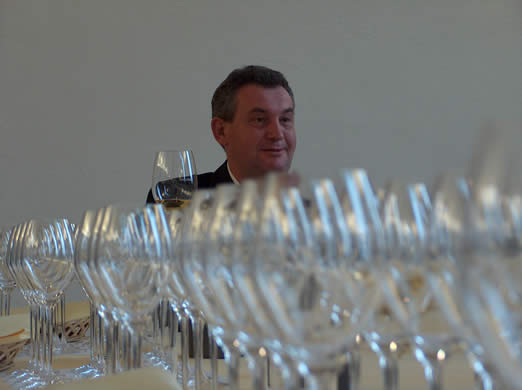
|
The wines
of Alois Kracher, Burgenland, Austria
Weinlaubenhof, Alois Kracher, Apetioner Straße 37, A-7142
Illmitz, Austria Editor's note: for a much more recent report on these wines, based on a visit in October 2004, see here
Forty-something Alois Kracher has a reputation for making Austria's best sweet wines, and on the basis of this tasting it's hard to see how anyone else could do much better. He's located in the village of Illmitz, on the east bank of the Neusiedlersee, a long, shallow lake in the extreme south of Austria adjoining the Hungarian border. This lake is the key to this region's success with sweet wines. The vineyards are located on the flat shores of the lake, and the mist that develops in the warm autumn makes this ideal territory for botrytis, the fungal infection that shrivels ripe grapes, concentrating their sweetness while preserving their acidity. Although these grapes look disgusting, they make small quantities of highly complex sweet wine, such as these tasted here. It's very hard to assess young wines like this, which, with their combination of massive sweetness and high acidity, will probably last longer than I will. But they really do seem to be stunning wines, showing awesome concentration and arresting complexity. As you'd expect, for wines that rely on the development of botrytis, which itself is dependent on a particular set of environmental variables, the quantity produced is highly vintage dependent. 1997, for example, produced just 1/20th of the quantity of the more successful 1998. Some of Kracher's wines are matured in traditional wooden vats, whereas others are given the full new barrique treatment (labelled as Nouvelle Vague). Although I'm usually a little wary about the overuse of new oak, it works very well here complementing these already powerful, rich-textured wines. Although I've rated all the wines the same, if I had to choose just one to drink tonight, it would probably be the Chardonnay-Welschriesling No. 7. These are all available from Noel Young Wines ( www.nywines.co.uk), and his prices are given in brackets after each note.Chardonnay Trockenbeerenauslese (TBA) No. 2 Nouvelle Vague 1998 Welschriesling TBA No. 4 Nouvelle Vague 1998 Chardonnay-Welschriesling TBA No. 7 Nouvelle Vague 1998 Grande Cuvée TBA No. 10 Nouvelle Vague 1998 |
